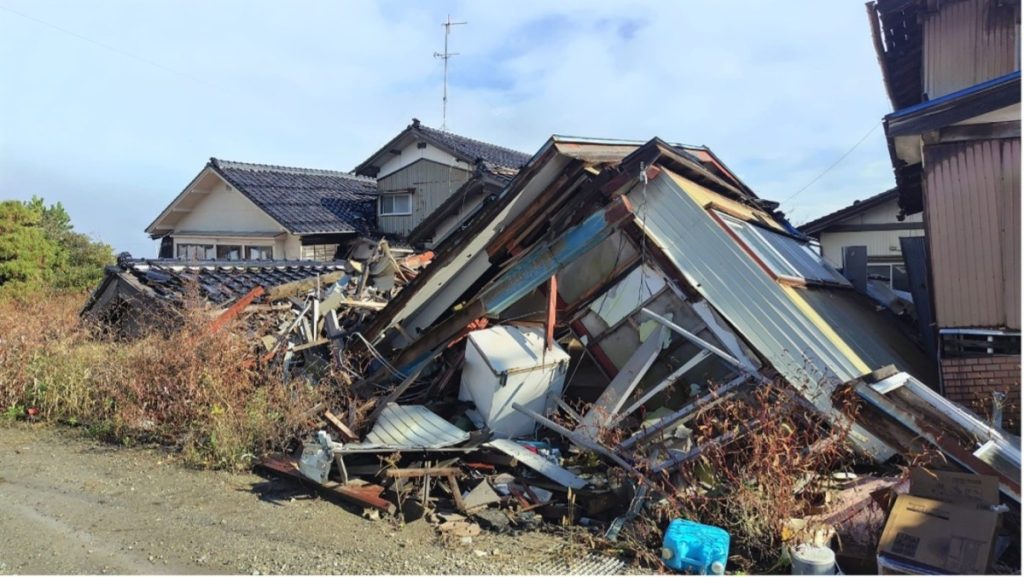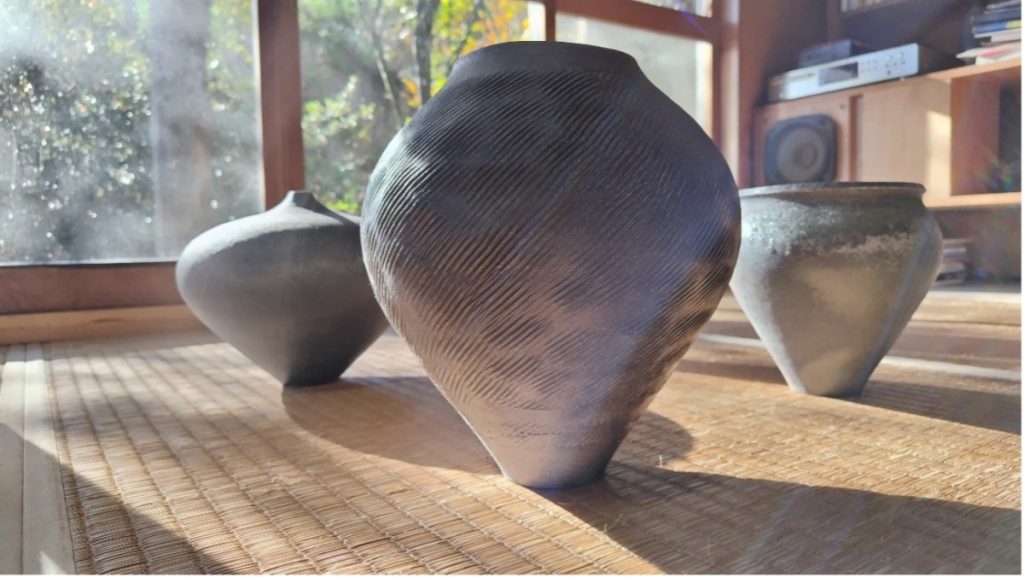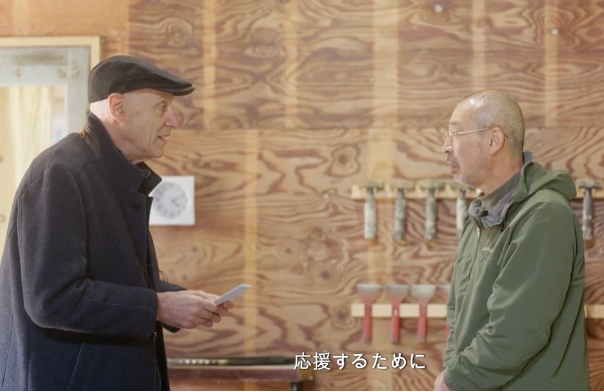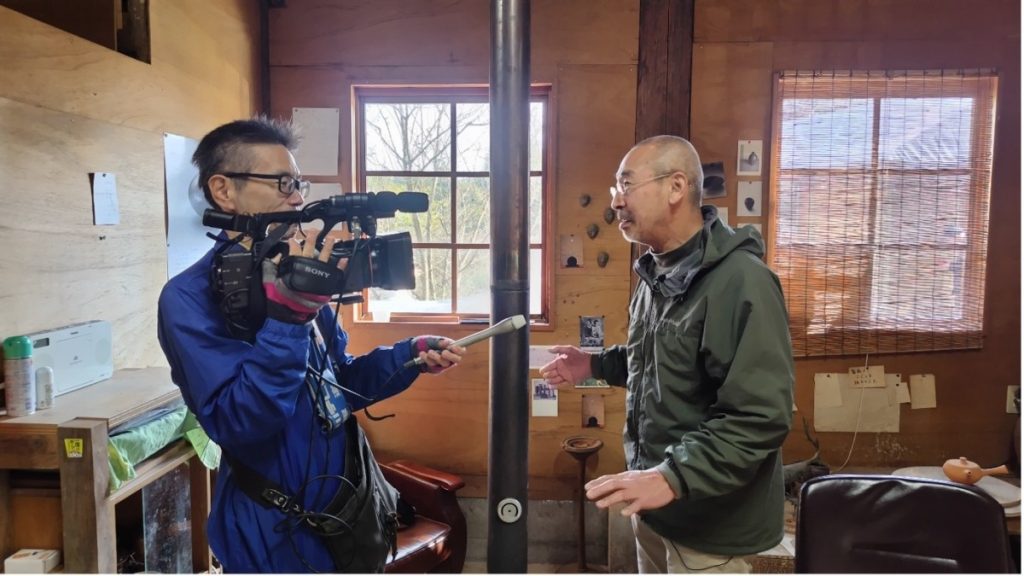I am writing this to you just after New Year’s Day from my home in Kyoto. Exactly one year ago today, I felt tremors in my living room, so I turned on Japanese television to the shocking news that a massive earthquake had hit the Noto Peninsula, less than 200 miles away.
The damage was immense. Homes that stood for hundreds of years had been shaken apart, collapsing upon their residents. Power lines were down. Water pipes had burst. Roads were buckled, broken, and blocked with landslides. Hundreds of people were missing and feared dead.

Image: Recovery is coming only slowly to the people of the Noto Peninsula. The rubble of these homes, which collapsed in the New Year’s Day 2024 earthquake, has yet to be cleared away. (Photographed in Suzu on Nov. 23, 2024 by Alice Gordenker)
The earthquake was a disaster not only for the people of Noto but also for Japanese traditional crafts. One of the hardest hit areas was the town of Wajima, where, for centuries, top-quality urushi lacquerware workshops have produced some of the most beautiful lacquerware pieces ever made in Japan. Another was the town of Suzu, where the production of a once-lost form of ancient unglazed pottery had only recently been revived. I love all Japanese ceramics, but there’s a special place in my heart for the elegant dark grey forms of Suzu ware, which embodies so much of Japan’s ceramic history and crafting skill.
Long ago, during Japan’s Middle Ages, Suzu was a thriving center for pottery production. It had good clay, plenty of wood for fueling the kilns, and ready access to transportation, which at the time was almost entirely via sea routes up and down Japan’s coasts. Pottery from Suzu was prized throughout the country for its beautiful dark-grey color and gorgeous patina, effects that could only be achieved through a laborious and fuel-intensive reduction-firing process.

Image: Beautiful Suzu ware pots made by Takashi Shinohara before the earthquake. Because his kiln was destroyed, he and all other potters in the community have been unable to produce any new work since. (Photo: Alice Gordenker)
Yet around the middle of the 15th century, Suzu experienced a calamitous decline as potteries in other parts of Japan became more efficient and adopted less expensive firing methods. Production in Suzu ceased, and Suzu ware was largely forgotten until 1951 when a large urn was unearthed in an archeological excavation. Efforts to revive the ancient craft began a few decades later, and by the time of the New Year’s Day disaster, eight potters were working in Suzu in truly authentic wood-burning kilns with technology perfected 1000 years ago. Every single one of their kilns was destroyed. Many potters also lost their workshops and homes and evacuated several hours away for shelter.
Although offers of humanitarian aid poured in from around the world, recovery has been slow to reach the Noto Peninsula, hampered by the remote location and extensive damage to the only road in and out. With a short supply of food, power, and shelter, volunteers from outside the area were asked to stay away until the situation stabilized. All the while, I received so many kind and concerned inquiries from JapanCraft21 members. Yet it was August before we could responsibly travel to Noto to offer our help.
JapanCraft21’s mission is to not simply support craftspeople but also to help them build a future for their craft by passing on critical skills to the next generation. Accordingly, and in consultation with Suzu’s people and experts in Japanese ceramics, we determined that the best way to speed recovery would be to fund the reconstruction of one of the destroyed kilns as a communal kiln to include young potters. This is not a simple project; the kiln must be hand-built and tailored to the specific wood-firing techniques that create Suzu ware’s distinctive grey-black color and beautiful patina. Very few people know how to construct such a kiln.
We developed a plan with Takashi Shinohara, 61, a native of Suzu and one of the community’s most experienced potters and kiln builders. With a special grant from JapanCraft21, Shinohara-san will rebuild his kiln with a small corps of younger potters, teaching them the skills to design, build and fire a Suzu ware kiln as a communal kiln. When it is complete, they will fire their works together, allowing Shinohara-san to transmit his firing skills to the next generation of Suzu potters.

Image: Suzu potter Takashi Shinohara (right) receives a JapanCraft 21 award of $25,000. He will teach key skills to young potters as together they build and fire a new communal kiln. Photo credit: Irwin Wong.
In a ceremony in Suzu on Nov. 23, 2024, JapanCraft21 presented Shinohara with $25,000 for materials and all related building costs during the reconstruction. The grant will also cover the cost of wood for the first several firings. About a month after the ceremony, we made an additional $2000 available to cover part of the cost to repair the road leading to the kiln that was washed out by recent record floods. I was so pleased reporters from local and national media outlets attended the ceremony. The favorable coverage they provided is helpful in gaining support for Noto, specifically, and the more general need to take action to preserve traditional crafts.

Image: Shinoharu-san talks to a reporter from Japanese television about the reconstruction plan. Photo credit: Alice Gordenker.
I am so grateful to JapanCraft21 members for the work we do together. Though our contribution will ensure the rebuilding of the kiln itself, more is needed to get this ceramics operation back on its feet. If you would like to contribute, please consider making a tax-deductible donation through our website, www.japancraft21.com.
You have my best wishes for a safe, happy, and successful year ahead.
Steve
Steve Beimel
Founding Director,
JapanCraft21

Comments
An inspirational piece, Steve. It’s an extraordinary achievement by JapanCraft21. Congratulations!
This seems to be a perfect fulfillment of the vision of Japan Craft 21.
Congratulations to Steve and every one of you who support this heartfelt endeavor.
Like a Phoenix rising up from the ashes, may the historic tradition and legacy of Suzu be reborn. An inspiring story of rebirth against all odds. JapanCraft21’s proactive iniative during a time of human calamity is inspiring for all.
A true humanitarian and historically conservative effort with grand results for everyone interested in Japanese ceramics. God Bless your work
In addition to your commitment to preserving Japanese arts and crafts, I want to acknowledge your over three and a half decades mission to bring an awareness and appreciation of Japanese arts and culture to us “westerners”. So many of us are grateful for the ongoing education you provide.
Thank you, Steve,for speaheading this visionary project and for continuing your great work with JC21.
Happy New Year Steve. Thank you for innovating such a worthwhile project. Congrats on each success and all the good that you do for Japanese artists, their families and the world of Craft. We, from afar, are lucky to benefit from your expertise, knowledge and generosity. I will continue to spread the word.
Quick note– “been” might need checking. I’ve used spellperfect.com effectively for these.
Thanks,
Zachary